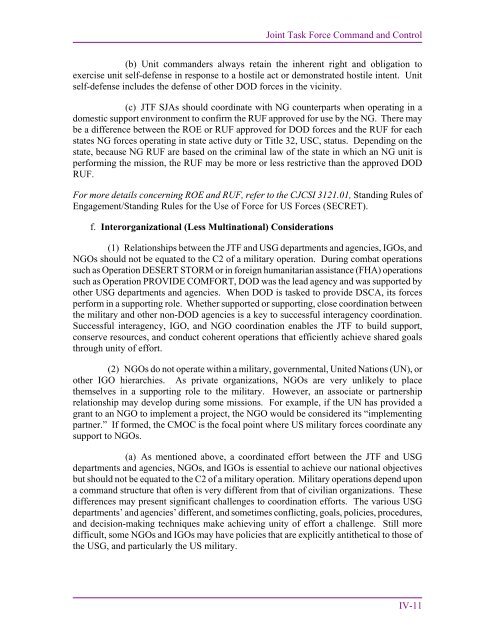JP 3-33, Joint Task Force Headquarters - Defense Innovation ...
JP 3-33, Joint Task Force Headquarters - Defense Innovation ...
JP 3-33, Joint Task Force Headquarters - Defense Innovation ...
Create successful ePaper yourself
Turn your PDF publications into a flip-book with our unique Google optimized e-Paper software.
<strong>Joint</strong> <strong>Task</strong> <strong>Force</strong> Command and Control<br />
(b) Unit commanders always retain the inherent right and obligation to<br />
exercise unit self-defense in response to a hostile act or demonstrated hostile intent. Unit<br />
self-defense includes the defense of other DOD forces in the vicinity.<br />
(c) JTF SJAs should coordinate with NG counterparts when operating in a<br />
domestic support environment to confirm the RUF approved for use by the NG. There may<br />
be a difference between the ROE or RUF approved for DOD forces and the RUF for each<br />
states NG forces operating in state active duty or Title 32, USC, status. Depending on the<br />
state, because NG RUF are based on the criminal law of the state in which an NG unit is<br />
performing the mission, the RUF may be more or less restrictive than the approved DOD<br />
RUF.<br />
For more details concerning ROE and RUF, refer to the CJCSI 3121.01, Standing Rules of<br />
Engagement/Standing Rules for the Use of <strong>Force</strong> for US <strong>Force</strong>s (SECRET).<br />
f. Interorganizational (Less Multinational) Considerations<br />
(1) Relationships between the JTF and USG departments and agencies, IGOs, and<br />
NGOs should not be equated to the C2 of a military operation. During combat operations<br />
such as Operation DESERT STORM or in foreign humanitarian assistance (FHA) operations<br />
such as Operation PROVIDE COMFORT, DOD was the lead agency and was supported by<br />
other USG departments and agencies. When DOD is tasked to provide DSCA, its forces<br />
perform in a supporting role. Whether supported or supporting, close coordination between<br />
the military and other non-DOD agencies is a key to successful interagency coordination.<br />
Successful interagency, IGO, and NGO coordination enables the JTF to build support,<br />
conserve resources, and conduct coherent operations that efficiently achieve shared goals<br />
through unity of effort.<br />
(2) NGOs do not operate within a military, governmental, United Nations (UN), or<br />
other IGO hierarchies. As private organizations, NGOs are very unlikely to place<br />
themselves in a supporting role to the military. However, an associate or partnership<br />
relationship may develop during some missions. For example, if the UN has provided a<br />
grant to an NGO to implement a project, the NGO would be considered its “implementing<br />
partner.” If formed, the CMOC is the focal point where US military forces coordinate any<br />
support to NGOs.<br />
(a) As mentioned above, a coordinated effort between the JTF and USG<br />
departments and agencies, NGOs, and IGOs is essential to achieve our national objectives<br />
but should not be equated to the C2 of a military operation. Military operations depend upon<br />
a command structure that often is very different from that of civilian organizations. These<br />
differences may present significant challenges to coordination efforts. The various USG<br />
departments’ and agencies’ different, and sometimes conflicting, goals, policies, procedures,<br />
and decision-making techniques make achieving unity of effort a challenge. Still more<br />
difficult, some NGOs and IGOs may have policies that are explicitly antithetical to those of<br />
the USG, and particularly the US military.<br />
IV-11

















